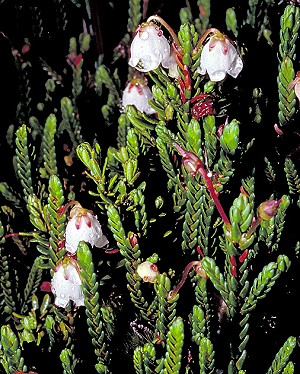
|
|
Cassiope
(Cassiope tetragona)
|
Cassiope
- Cassiope Spp.
Cassiope is a genus of 9-12 small shrubby species in the family
Ericaceae.
This group of hardy, dwarf, evergreen shrubs are natives of the Himalayas, Asia, North
America,
North Europe and Arctic. Common names, shared with several other similar related
genera, include heather and heath. They are usually found in dry stony or sandy heaths or
tundra-usually in mountainous areas.
These plants do better in cool climates where summers aren't too
warm. They can withstand temperatures as low as -35o C. Cassiopes are suitable for growing in shady or
semi-shady places of the rock garden or shrub border. They
require dry, moist, lime-free, well-drained soil. These plants have tiny,
compact, overlapping leaves and solitary, bell-shaped flowers that resemble
Lilies-of-the-Valley. The flowers are hermaphrodite (have both male and female
organs) and are pollinated by insects.
The genus is named after Cassiopeia of Greek mythology. Cassiopeia
also is a northern constellation which Greek mythology considered to represent the vain queen Cassiopeia who boasted about her unrivaled
beauty.
The Queen Cassiopeia, wife of King Cepheus of the mythological Phoenician realm of
Ethiopia,
and mother of Andromeda was beautiful but also arrogant and vain; these latter two characteristics led to her
downfall.
Cassiope mertensiana is a species of flowering plant known by the common names western moss heather and white mountain
heather. This heather is native to subalpine areas of western North America, from Alaska to the mountains of
California. It is a small, branching shrub which forms patches along the ground and in rocky
crevices. The short, erect, snakelike stems are covered in tiny leathery scalelike leaves only a few millimeters
long. From between the layers of scale leaves emerge reddish pedicels each bearing a
petite, hanging, down-facing, bell-shaped flower. The bractlets are red and the contrasting flower is
white.
Cassiope tetragona (common names include Arctic
bell-heather, white arctic mountain heather and Arctic white heather) is a plant native to the high Arctic and northern
Norway, where it is found widely. It grows on ridges and heaths, often in
abundance and forming a distinctive and attractive plant community.
Growing to 10–30 cm in height, it is a strongly-branched dwarf shrub. It is in leaf all
year, in flower from April to May. The leaves are grooved, evergreen, and scale-like in 4
rows. Pedicels are long and arched. The plant bears bell-shaped, solitary flowers usually with white and pink lobes and pink
anthers. The flower stalks and sepals are red, but the petals may also be
yellowish-white. The anthers can also be brownish-yellow and flower stalks and sepals
yellowish-green.
The plant, combined with mosses and lichens, has been used as an insulation material in houses The plant makes a good
tinder. In Greenland, the plant is important as fuel. Considering the size of the plant
(up to 30cm), this use must be born out of desperation in areas with very few woody
plants.
Source:
http://en.wikipedia.org/wiki/Cassiope
http://www.botany.com/cassiope.html
http://www.iflorist.co.uk/p-1358-cassiope.aspx
http://en.wikipedia.org/wiki/Cassiopeia_(constellation)
